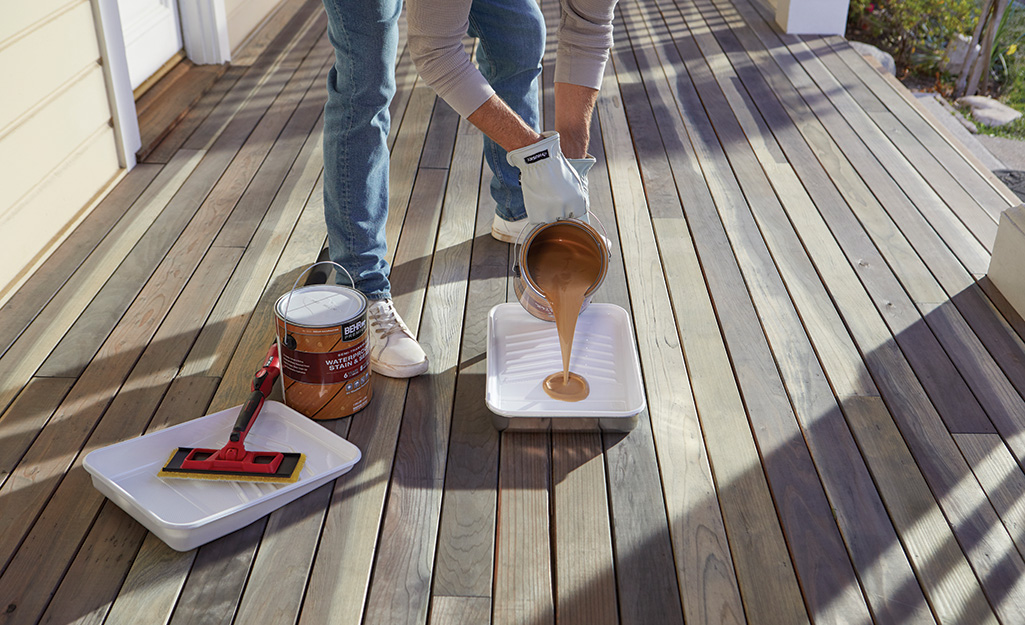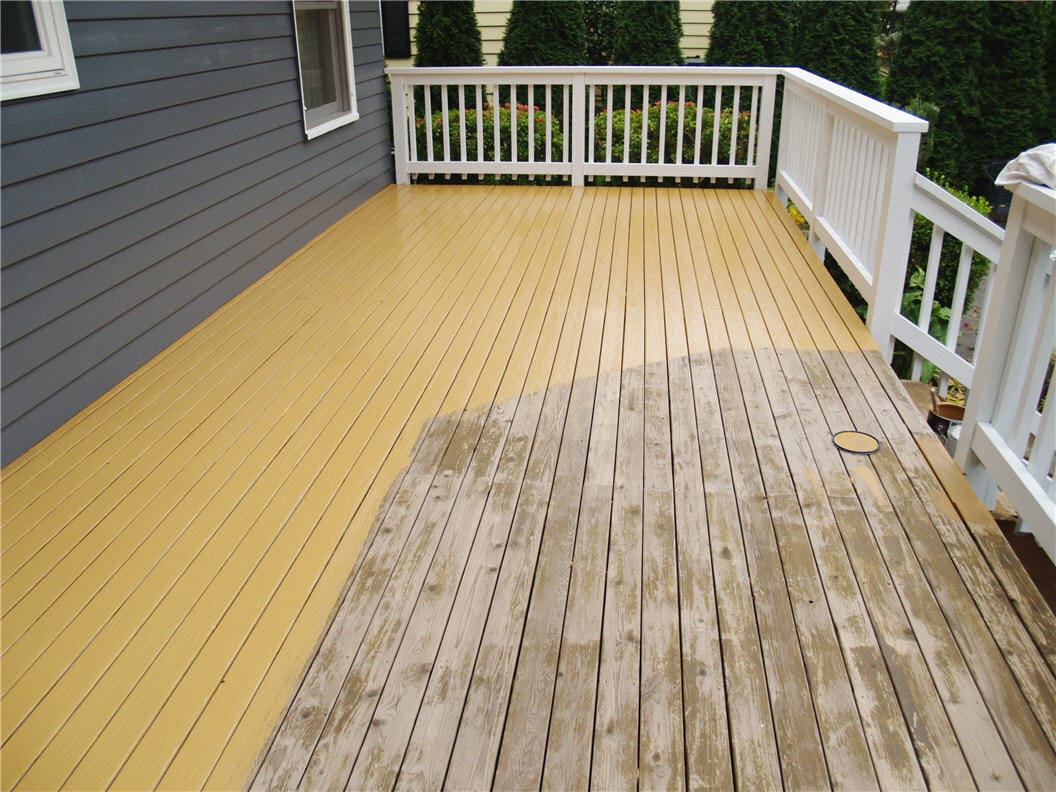Preserve and Improve: Revealing the Art of Fence Staining
Wiki Article
Picking the Right Spot for Your Fencing: Tips and Considerations
When it comes to improving the appearance and preserving of your fence, selecting the ideal tarnish is crucial. We will explore the different types of fence discolorations, elements to think about before choosing a tarnish, suggestions for preparing your fence for staining, and the distinctions in between oil-based and water-based spots. Furthermore, we will delve into picking the appropriate tarnish shade to match your fencing and improve your outside space.Understanding Various Kinds Of Fencing Spots

On the other hand, water-based spots are made from acrylic or latex and offer a much more refined color to the timber. They create a protective film externally of the wood, protecting against wetness from permeating in and shielding against UV damages. Water-based discolorations are simpler to cleanse up and have a much faster drying time compared to oil-based stains. They are also less likely to fracture or fade in time.
Picking between oil-based and water-based discolorations depends upon numerous elements, consisting of personal preference, the preferred look, and the level of upkeep required. Oil-based stains are suggested for surround high-traffic locations or those continuously exposed to extreme weather. fence staining. Water-based spots, on the other hand, are a preferred choice for fence houses where look and convenience of use are crucial
Comprehending the distinctions between water-based and oil-based spots aids home owners make an educated decision when choosing the best discolor for their fence. Taking into consideration the details requirements of the fence, such as its location, direct exposure to sunlight, and preferred visual, will certainly make sure that the chosen stain gives resilient protection and boosts the general appeal of the fence.
Variables to Think About Before Selecting a Spot

Various types of wood take in spots in different ways, resulting in varying levels of color intensity and sturdiness. Additionally, particular woods might be extra vulnerable to problems like rot or insect infestation, which may affect the option of discolor to protect the fencing and safeguard.
The environment and climate problems in your location must likewise be thought about. You might require a stain that provides added protection against dampness and UV rays if you live in an area with harsh winters months or high moisture. Also, if your fence is revealed to direct sunshine for extended periods, a discolor with UV inhibitors can aid avoid fading and staining.
Lastly, it is necessary to consider your desired visual. Different discolorations provide numerous colors and coatings, enabling you to customize the look of your fencing (fence staining). Think about the general design and style of your residential property, along with any neighborhood guidelines or house owner association guidelines that might dictate the acceptable tarnish shades
Tips for Preparing Your Fence for Staining
Cleaning the fencing is an important step as it removes dust, crud, and any kind of previous layers that might conflict with the discoloration process. Scrub the surface gently, paying extra attention to locations with persistent spots or mold.After cleaning, allow the fencing to completely dry totally. fence staining and sealing. This action is crucial as discoloring a damp or damp surface can lead to inadequate attachment and an unequal coating. Relying on the climate condition, it may take anywhere from a couple of hours to a couple of days for the fencing to dry thoroughly. Make certain that the fencing is completely dry before proceeding with the discoloration process.
Prior to staining, check the fencing for any damages, such as loose boards or nails. This product aids to open the wood pores, permitting the stain to pass through try this website more successfully and equally.

Comparing Water-Based and oil-based Spots
When selecting a tarnish for your fence, it is very important to compare the features and benefits of water-based and oil-based spots. Both kinds of spots have their own benefits and factors to consider, so it is crucial to recognize the differences in between them.Oil-based stains are recognized for their sturdiness and resistance to deterioration. They permeate deeply right into the wood, supplying excellent defense against the components. They also improve the all-natural charm of the timber by highlighting its grain and structure. In addition, oil-based discolorations tend to last longer than water-based spots, making them a preferred option for fencings.
On the other hand, water-based discolorations are extra ecologically friendly and less complicated to clean up. They may not supply the very same degree of protection as oil-based spots, especially in harsh weather condition conditions.
Inevitably, the option in between oil-based and water-based discolorations depends on your details demands and choices. When making your decision, consider aspects such as durability, environmental influence, and simplicity of application. Consulting with a professional or looking for recommendations from experts can likewise help make certain that you select the appropriate tarnish for your fencing.
Choosing the Right Discoloration Color for Your Fencing
The selection of an ideal discolor color for your fence is an essential element of boosting its aesthetic appeal and matching the total style of your exterior space (fence staining and sealing). The appropriate stain color can transform a level, common fencing right into a striking prime focus that adds depth and personality to your propertyWhen picking a tarnish color for your fence, it is very important to take into consideration the design and style of your home. Earthy tones such as browns and neutrals can develop a cozy and inviting appearance if you have a standard or timeless style home. On the various other hand, if you have a contemporary or contemporary home, you may consider choosing bold and vibrant colors that make a statement.
Another element to think about is the all-natural surroundings of your building. If you have a lot of plant, a stain color that complements the natural landscape, such as greens or crimsons, can develop a cohesive and unified look.
Furthermore, it deserves considering the upkeep needed for different discolor colors. Lighter colors have a tendency to show dirt and put on even more quickly, while darker shades can conceal blemishes and require much less regular touch-ups.
Eventually, the choice of tarnish shade for your fence must show your personal style and choices - deck staining companies near me. Put in the time to discover various alternatives and consult with specialists if required, to guarantee that you choose the best stain color that improves the charm and allure of your fencing
Conclusion
Finally, when it concerns selecting the appropriate tarnish for your fence, it is essential to understand the various kinds of discolorations available and consider aspects such as durability and wanted appearance. Preparing the fence correctly prior to discoloration is essential for attaining optimum results. In addition, comparing water-based and oil-based stains can assist identify the very best option for your certain requirements. Last but not least, selecting the ideal discolor color can improve the overall looks of your fence.We will discover the various types of fencing spots, variables to consider prior to picking a stain, suggestions for preparing your fencing for discoloration, and the distinctions in between oil-based and water-based spots.Distinguishing in between oil-based and water-based discolorations is essential when comprehending various types of fence discolorations. Water-based spots are less complicated to cleanse up and have a faster drying time compared to oil-based stains. In addition, oil-based spots have a tendency to last longer than water-based stains, making them a prominent option for fencings.
In final thought, when it comes to selecting the appropriate tarnish for your fence, it is essential to understand the various kinds of discolorations offered and consider variables such as durability and desired appearance.
Report this wiki page